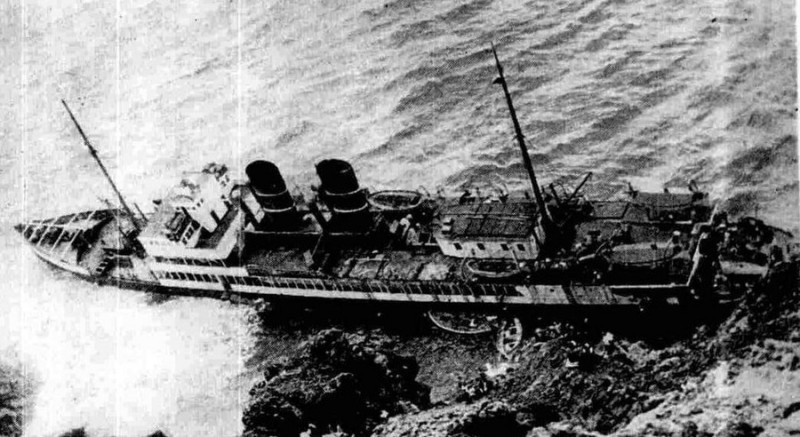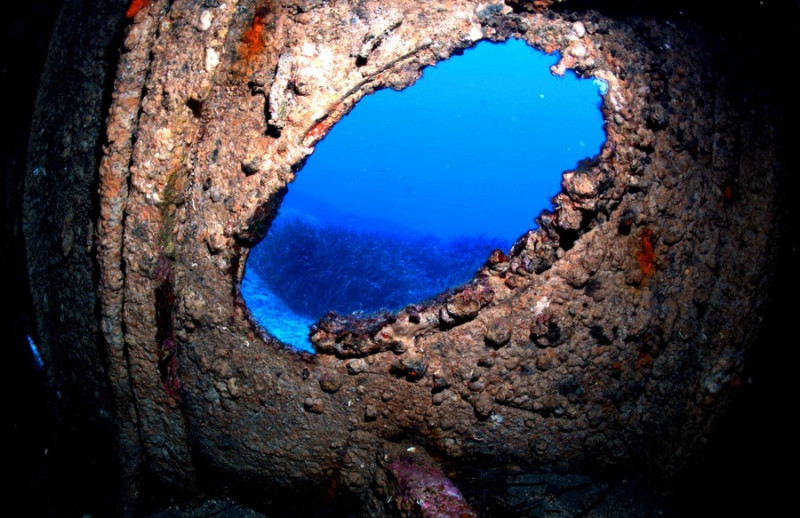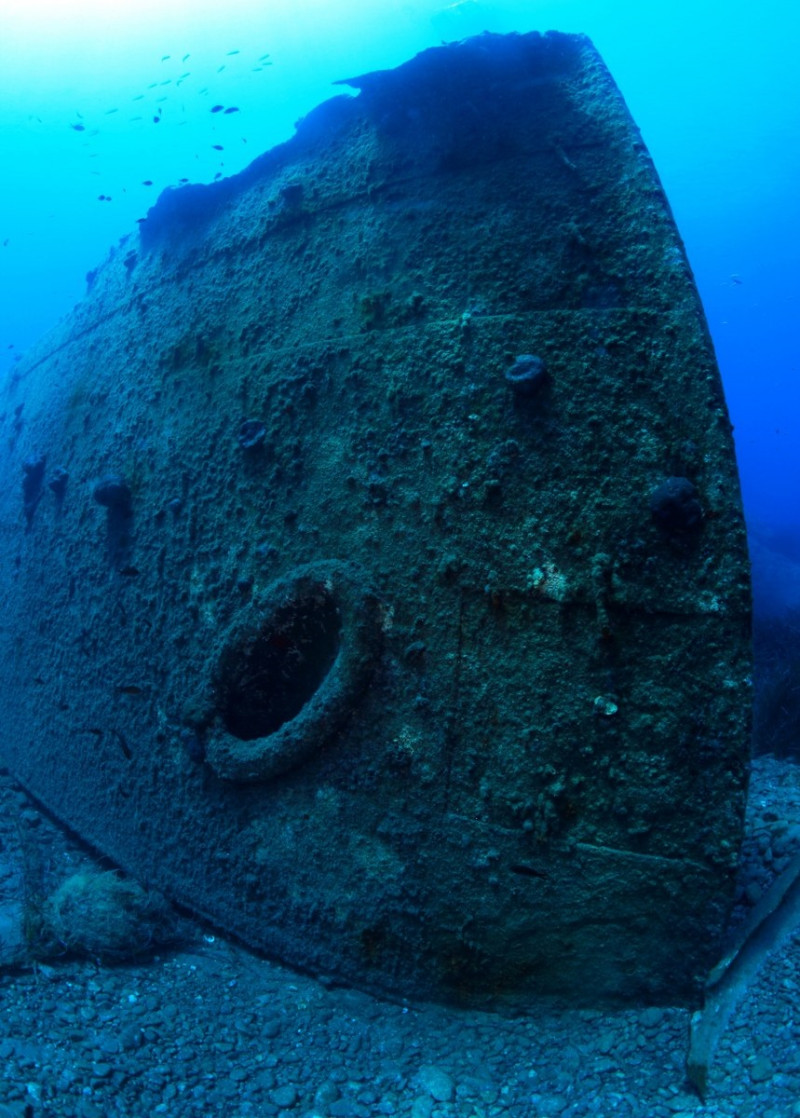For the first time, images from the steamship Falconera, the only shipwreck, which sank 73 years ago after running aground, have been released
OCTOBER 1951: “We have run aground right Falconeras. We’re leaning to the right and we’re constantly sinking.”
For the first time, images from the steamship ADRIAS are seeing the light of day, the only wreck of the Falconera, which sank 73 years ago after running aground. These are photos taken on the seabed by researcher Kostas Thoktaridis and his team, at the beginning of September. The wreck of the ADRIAS steamship is located near the cove called Panagia ton ryumas tis Falconera. “The specific sea area has strong underwater currents and the wreck is located at a depth of -24.5 m with the impressive bow inverted. The fissures made can be seen in October 1951. Its portholes and portholes still stand out from the ship’s cabins. The compartments in the forward part of the ship were among the first to be flooded. The rest of the ship has been broken up by the gradual lifting that followed over the next few years with the aim of selling the metals that were of considerable value. The underwater visibility is excellent, while the wreck has abundant marine life,” says Mr. Thoktaridis to APE-MPE, unfolding the story of this particular wreck, which he has been researching for years.
The wreck of “Adrias”
“ADRIAS” captained by Gerasimos Fokas, crew of 78 men as well as 538 passengerswho had boarded from Heraklion, Rethymno and Chania (Souda) in Crete, had a final destination of Piraeus.
At 04:15 on the morning of October 6, 1951, while a northeasterly wind was blowing with intermittent rain, a loud noise was heard, followed by a strong jolt. Most of the passengers were startled from their sleep. ADRIAS collided with Falconera at a speed approaching 13 knots. The captain of the ship was in his cabin. The governor had a shift on the bridge. The impact was a result of the deviation of his course aided by the prevailing northeasterly winds in the area. As soon as the ship ran aground, the governor immediately stopped the engines and then reversed. With this movement, the ship was detached from the rocky shore, but fortunately at that moment, the master came to the bridge, who ordered both engines forward and the ship ran aground again on the rocks of Falconera. Then he set both anchors and with suitable movements brought the steamer close to the rocks of Falconera.
This action of the master saved the lives of the passengers, since the ship came very close to the rocky coast and was no longer in immediate danger of sinking.
The ship was still lit and the passengers gathered to the port side.
Danger signal
The master then ordered the radio operator to send a distress signal, which ADRIAS transmitted by morse telegraphy.
The signal was received by the steamer VIOTIA as well as the steamer TETI, which transmitted it to the steamer AEGION and in turn relayed it to the coastal station ATHINAI RADIO with the distinguishing mark SVA which was then based in Vari.
The coastal station ATHINAI RADIO, in turn, informed the maritime and port authorities. At the same time, the service of the Ministry of Commercial Shipping sent urgent telegrams to the port authorities of Crete to report the names of those who boarded from Crete.
ADRIA’s radio stopped working at 07:30 in the morning when it transmitted the following dramatic radio telegram: “We have right sided Falconeras. We are tilting to the right and we are constantly sinking” and the ship was abandoned.
The passenger steamships IÓNIA and AIGAIO, the motorship GEOPGIOS and the tanker of P. N. AΜIOS also arrived at the place of the grounding.
Disembarking at Falconera
When it began to dawn, the captain ordered the boats to be launched and the passengers disembarked at a steep part of the island, with the guidance of the crew members. Members of the crew of the cargo ship “Antonios Pateras” as well as captain Laimos were also traveling with the ship, who helped with some soldiers in the coordination during the abandonment by ADRIA.
Loss
All passengers and crew boarded the ships that rushed to helpexcept for the passenger Ethalia Karyda, who was found in the sea, as a result of which she drowned. As Paraskevi Daskalaki, E. Karyda’s sister, testified: “Me, my sister and little Stella Hakatidou boarded ADRIA from Heraklion. We awoke in fright, and my sister, overcome by nervousness, rushed first to the stern where other passengers had gathered. Then I saw her jump the handrail and grab hold of a cable that the crew had tied to the Falconera rocks. Despite my recommendations she insisted on floating ashore. Unfortunately, she didn’t make it and in a moment, obviously tired, she let go of the rope and fell into the sea. We heard her shouting for help and the policeman I. Fakiolakis took out his personal life jacket and threw it into the sea. Despite our searches, she was never found.”
The Commission’s conclusion
As for the causes of the grounding, according to opinion 58/1952 of the Supreme Council of Marine Accidents, the grounding of the ADPIA was caused by an emission to the left of the course due to the weather condition or any incorrect courses followed from Cape Malecha of Souda to Falconera. The committee exonerated the master of any responsibility and blamed the captain and the lieutenant who were on the bridge at the time of the grounding.
The stranding that resulted in a shipwreck
The ship ran aground in Falconera, on two different pieces of land and suffered a 12-meter breach. An attempt was made to restore the fault by a team of divers of the time. As part of lightening the ship, food and large quantities of meat carried by the steamer in its refrigerators were thrown into the sea. This, however, had the effect of attracting sharks, which delayed the ship’s waterproofing work. Finally, the waterproofing was successfully completed and the water was pumped out. Then the weather changed to a strong southeasterly and the towing crews with the tugs left for Milos. When after three days they returned to Falconera, the ship was no longer there, it had sunk!
ADRIAS was insured and was considered a total loss.
The identity of the steamer ADRIA
Built 1893 at HARLAND AND WOLF shipyards, BELFAST as MAGIC, 311 feet long, for the Belfast Steamship Company. It originally served the Liverpool-Belfast route. In the first world war, it was used as a floating hospital.
In 1930 she was converted into a cruise ship making cruises between England and Scotland. In the winter she operated between Fishguard-Cork and in the summer she cruised to Scotland. In the second world war it was used as a floating depot at Rosyth. In 1947 she was bought by Bury Court Shipping Co and renamed “Attiki”. It operated routes between Marseille-Genoa-Piraeus-Virit-Haifa-Alexandria.
In 1948 it was bought by Potamiano’s Continental and named ADRIAS serving the ferry connection Piraeus – Thessaloniki – Crete – Chios – Rhodes and was considered one of the best ships in Greek passenger shipping.
The wrecks of the Falconera
In Falconera there is no other shipwreck except that of ADRIA. Falconera is historically linked to two other shipwrecks.
The ARETI, which had set sail from Piraeus with a crew of 16 men and 6 passengers and was bound for Crete, capsized on the evening of February 6, 1949, north of Falconera, with the loss of 21 people. Only the sailor of ARETI Dimitris Giapitzoglou was saved. Dimitris Yapitzoglou’s story is shocking as he stayed on the FALCONERA for 8 days and nights and was finally spotted by an air force aircraft which in turn notified the authorities and then the ADRIAS steamer arrived the next day and rescued him. The tragic irony is that three years later, in the same spot where the shipwreck was received, ADRIAS sank!
In December 1966, the HERACLEION ferry will sink northwest of Antimilos at a great depth, but erroneously for the next few years, the opinion will prevail that it sank near Falconera. The wreck of HERACLEION should be called the wreck of Antimilos and not Falconera due to its geographical location.
Also, during the Occupation, a transport aircraft that has not yet been found crashed north of Falconera.
Source: Skai
I have worked as a journalist for over 10 years, and my work has been featured on many different news websites. I am also an author, and my work has been published in several books. I specialize in opinion writing, and I often write about current events and controversial topics. I am a very well-rounded writer, and I have a lot of experience in different areas of journalism. I am a very hard worker, and I am always willing to put in the extra effort to get the job done.














